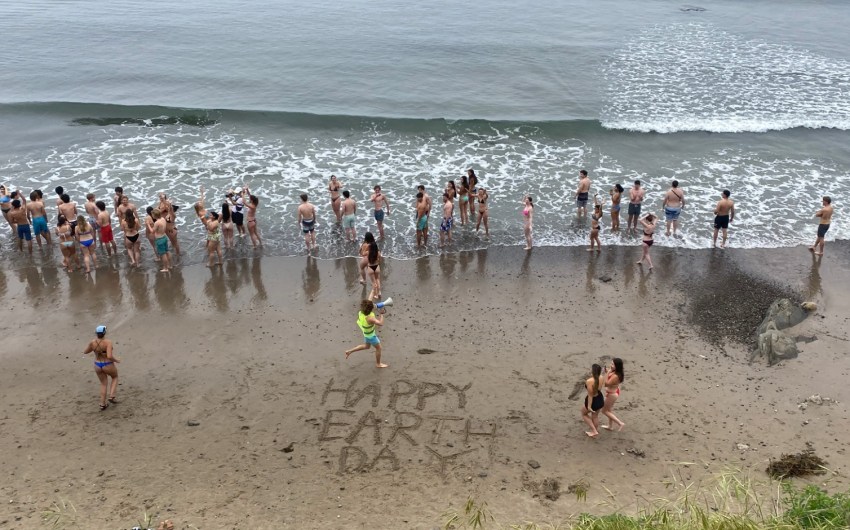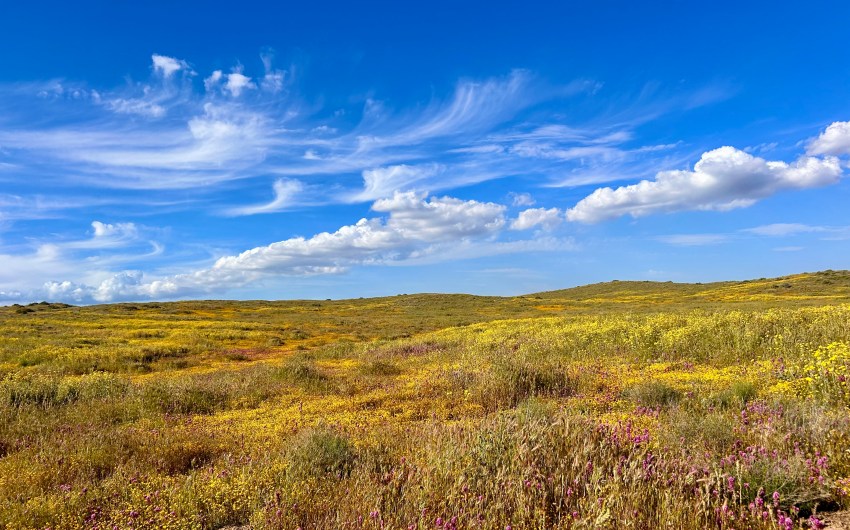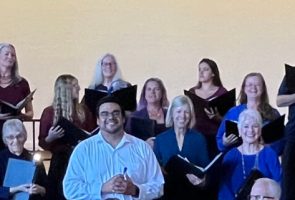Dreaming of Oil in Cuyama, Next to Harvard’s Grapes
Michigan-Based Company Wants to Drill Exploratory Well Two Miles Deep

There are about 2,000 active oil wells in the North County, long past their boom days, spread over half a dozen vintage oil fields from Lompoc to the Cuyama Valley. Some of the oil eking out of them now has the consistency of tar.
No one has proposed drilling an onshore exploratory oil well here for at least 10 years and likely much longer, county planners say. The existing fields are nearing exhaustion; drilling for oil is expensive, and a switch to solar and wind projects is getting underway in a dangerously warming world.
So in some ways, it’s surprising that the West Bay Exploration Co., the largest oil producer in Michigan, is seeking a county permit to drill a test oil and gas well on a private ranch in the Cuyama Valley.
“We just don’t see a lot of folks taking this type of risk these days,” said Errin Briggs, a supervising planner in the county’s Energy, Minerals & Compliance Division.
The Hidden Canyon Test Well, as the West Bay project is called, is proposed for one acre in the center of the 6,565-acre North Fork Ranch off School House Canyon Road, 10 miles west of New Cuyama, a rural community of about 700 people. The ranch is owned by Brodiaea Inc. of San Luis Obispo and is part of Harvard University’s $51 billion endowment fund.
In 2012, Brodiaea planted an 840-acre vineyard on the property, instantly becoming one of the biggest water users in the arid agricultural region. But Brodiaea doesn’t own the mineral rights to natural resources underground; West Bay is leasing those rights from an unidentified group of owners.
West Bay’s permit application will be reviewed by the county Planning Commission on January 31. Uncharacteristically, the well would be 11,000 feet, or just over two miles, deep, while most onshore wells are between 800 and 5,000 feet deep. And unlike most onshore wells, it would be located outside an existing oil field.
Based on seismic surveys of the site, West Bay is hoping to hit a “good-sized reserve” on the North Fork Ranch, Tim Baker, the project manager, said.
“We think the area has a lot of potential,” he said, adding, however, “It’s hard to tell. It takes cold cash and cold steel to figure out what’s been going on. The shallow stuff has been found, so we thought we would drill a deeper test and see what’s there.”
West Bay proposes to spend 24 days drilling its test well, after which time, the drill rig would immediately be removed. Within one year, assuming that the company didn’t want to produce oil and gas on the site, it would abandon the well by removing the wellhead. If West Bay wanted to produce oil and gas at the North Fork Ranch, it would be required to apply for a county oil drilling and production permit.
“We can’t easily get totally away from fossil fuels,” Baker said, noting that they are used in plastics, medicines, and many other products. “The idea is to embrace all forms of energy and use them carefully in terms of the environment, and that’s sort of our mantra.”
Los Padres ForestWatch, a Santa Barbara conservationist group, is asking the commission to reject West Bay’s exploratory drilling plan.
“At a time when the state needs to be urgently reducing its greenhouse [gas] emissions, approving the plan would lead us in exactly the wrong direction,” Jeff Kuyper, the executive director, wrote in a letter to the commission last fall.
According to an Energy Division staff report on the project, an estimated 1,100 tons of greenhouse gases — carbon dioxide, nitrous oxide, and methane — would be released during construction and operation of the test well, an impact that the county deems “less than significant.”
In his letter, Kuyper argued that the county should be analyzing the potential greenhouse gases from a long-term oil project on the North Fork Ranch, instead of taking a “piecemeal” approach.
“The applicant would not be investing significant sums of money in exploratory drilling unless production was reasonably foreseeable,” Kuyper said.
Briggs disagrees. “Typically, we would study everything all at once,” he said, “but in this case, they’re only asking to explore; they’re not asking to produce. It’s totally speculative.”
Brodiaea representatives did not return requests for comment on the West Bay project this week, and the Harvard Management Co., which oversees the university’s endowment, declined to comment. In 2021, bowing to years of pressure from faculty and students, the university pledged to divest from its investments in fossil fuels. That creates an awkward situation for Harvard at the North Fork Ranch. There are few restrictions on where the owners of mineral rights — or in the case of West Bay, a lessee of those rights — can choose to drill for oil, other than next to homes.
Greenhouse gases trap the heat of the sun in the atmosphere, warming the surface of the earth. At Governor Gavin Newsom’s direction, the California Air Resources Board is evaluating how to phase out oil extraction and refining in the state by 2045. And Santa Barbara County’s 2030 Climate Action Plan, still in draft form, is tentatively proposing to cut greenhouse gases by half (below 2018 levels) by the end of this decade.
Fully half of the county energy division’s work is now in renewables, Briggs said; a prominent example is the Strauss Wind Energy Project in the Lompoc Hills. As of late December, after more than 20 years of review and a change in ownership, its 27 wind turbines are finally up and running and generating electricity. It is the only wind farm on the California coast.
There are nine plugged and abandoned oil wells from past exploration attempts on the North Fork Ranch. Most oil wells in the North County are in existing oil fields: Cat Canyon (the largest, discovered in 1908); Lompoc (1903); Orcutt (1901); Santa Maria Valley (1934), and Zaca (1942); plus two in the Cuyama Valley — South Cuyama (1949) and Russell Ranch (1948). West Bay is proposing to drill its well 1.6 miles west of the nearest active well in the Russell Ranch field.
Baker, the West Bay project manager, noted that California relies heavily on foreign oil imports: They comprise more than half the crude oil that is refined in the state. Unlike many foreign oil companies, he said, West Bay has been pioneering oil well technology that can capture methane, by far the most potent heat-trapping greenhouse gas, before it escapes into the air.
“We’re not being very good stewards when we’re increasing our imports of oil from companies that don’t care about their methane,” Baker said.
West Bay’s application in the Cuyama Valley comes at a time when water, not oil, is foremost on residents’ minds. The vast groundwater basin has been severely depleted by 75 years of over-pumping — initially, for alfalfa, and now for carrots. Facing state-mandated cutbacks, the biggest pumpers have filed a water rights lawsuit against all other users, including the school district and three small water districts.
Would West Bay ultimately convert its exploratory oil well to a water well? It’s a question some residents are asking. In the existing oil fields, it’s common practice to convert exhausted oil wells to water wells. Oily water that is pumped out in large quantities can be injected back into the ground. Since oil floats on water, the re-injected water puts pressure on the underground oil reservoirs, “pushing” the oil toward still-active wells.
But Baker said it would be “silly” to turn West Bay’s test well into a water well.
“We don’t want to find water,” he said.
Melinda Burns is an investigative journalist with 40 years of experience covering immigration, water, science, and the environment. As a community service, she offers her reports to multiple publications in Santa Barbara County, at the same time, for free.
Premier Events
Thu, May 02
5:00 PM
Santa Barbara
Things with Wings at Art & Soul
Sat, May 04
10:00 AM
Lompoc
RocketTown Comic Con 2024
Wed, May 01
7:30 PM
Santa Barbara
American Theatre Guild Presents “Come From Away”
Thu, May 02
5:00 PM
Santa Barbara
100th Birthday Tribute for James Galanos
Thu, May 02
5:00 PM
Santa Barbara
Meet the Creator of The Caregiver Oracle Deck
Fri, May 03
4:00 PM
Santa Barbara
Santa Barbara Fair+Expo “Double Thrill Double Fun”
Fri, May 03
8:00 PM
Santa barbara
Performance by Marca MP
Sat, May 04
10:00 AM
Solvang
Touch A Truck
Sat, May 04
11:00 AM
Santa Barbara
Mental Wellness Center’s 28th Annual Arts Faire
Sat, May 04
11:00 AM
Santa Barbara
Community History Day
Sat, May 04
3:00 PM
Solvang
The SYV Chorale Presents Disney Magic Concert
Sat, May 04
7:00 PM
Santa Barbara
A Star Wars Cantina Celebration: Renegades, Rebels, and Rogues
Thu, May 02 5:00 PM
Santa Barbara
Things with Wings at Art & Soul
Sat, May 04 10:00 AM
Lompoc
RocketTown Comic Con 2024
Wed, May 01 7:30 PM
Santa Barbara
American Theatre Guild Presents “Come From Away”
Thu, May 02 5:00 PM
Santa Barbara
100th Birthday Tribute for James Galanos
Thu, May 02 5:00 PM
Santa Barbara
Meet the Creator of The Caregiver Oracle Deck
Fri, May 03 4:00 PM
Santa Barbara
Santa Barbara Fair+Expo “Double Thrill Double Fun”
Fri, May 03 8:00 PM
Santa barbara
Performance by Marca MP
Sat, May 04 10:00 AM
Solvang
Touch A Truck
Sat, May 04 11:00 AM
Santa Barbara
Mental Wellness Center’s 28th Annual Arts Faire
Sat, May 04 11:00 AM
Santa Barbara
Community History Day
Sat, May 04 3:00 PM
Solvang
The SYV Chorale Presents Disney Magic Concert
Sat, May 04 7:00 PM
Santa Barbara
























